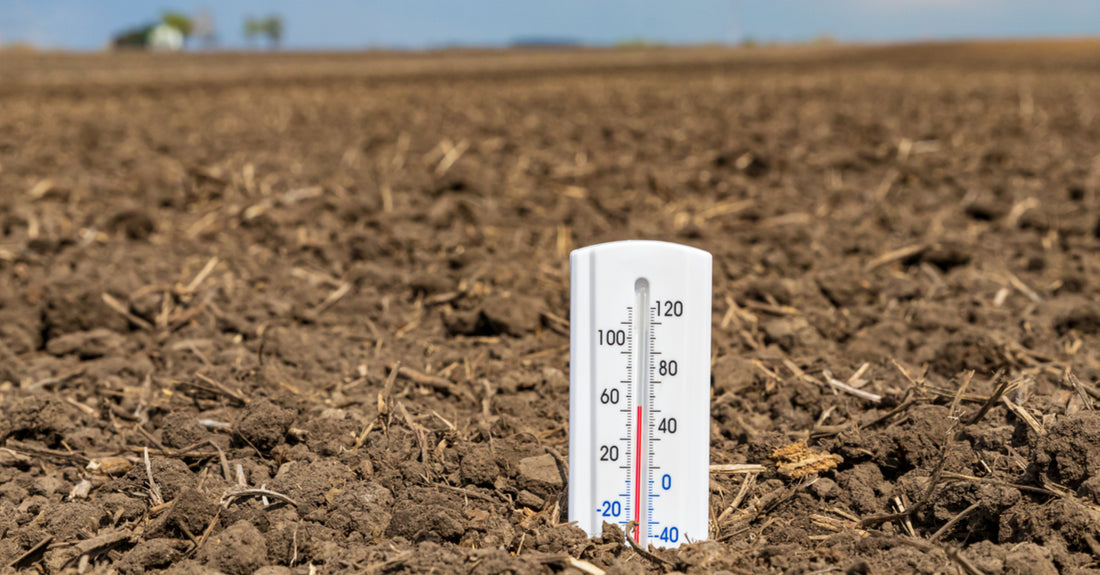Did you know that your soil temperature is directly connected to the success of your seed germination rates? Have you tried starting seeds indoors just to be disappointed in failed seed germination? Have you ever direct sown seed outdoors and wondered why nothing sprouts from the ground?
If so, your soil temperature is likely to blame. If soil conditions are too hot or too cold, your seeds may take much longer to sprout or may not germinate at all. Soil temperatures are one the most often overlooked details in seed starting yet one of the most important for germination success.
Here are 3 tips on soil temperature regulation for seed germination success!
Soil Temperature and Seed Germination Success
1. Why soil temperature matters in seed starting
The seed’s germination process is a chemical reaction. This chemical reaction happens when all the right conditions are present--moisture, oxygen, light, heat, and seed. The temperature of the soil can speed up this reaction or slow it down. This chemical reaction helps break down the seeds protective coating and tell the seed that is time for the seed to wake up and begin germination. Different seeds are naturally programed to germinate in different soil temperatures, based on their natural/native habitats. If we take a tomato seed, whose native habitat was originally South and Central America where the soil is very warm, and try to start that tomato seed in soil temperatures that are cool, the seed’s germination rates will be low or unsuccessful. Brassica’s, on the other hand, require cooler temperatures for healthy growth. Exposing brassica seeds and seedlings to hot soil temperatures can result in stressed plants, undesirable flavor, and can cause the plant to prematurely bolt (go to seed). Seeds vary in preferred soil temperature and soil temperatures will need to be adjusted to each seed’s specific needs.
2. Varying Soil Temperatures for different seeds/Soil Temperature Chart for Seed Germination
Ideal soil temperatures will vary from plant to plant, but an easy way to know how hot or cool your soil temperature needs to be for your seeds is to think like the plant you want to grow.
*Cool weather crops like leafy greens, onions, peas, and brassicas are grown in cooler weather and will germinate best in mild soil temperatures between 50-75 degrees.
*Spring Crops like beans, carrots, beets, and radishes do well in 60–75 degree soil.
*Summer crops that require the warmest soil to germinate are vegetables like corn, tomatoes, peppers, eggplants, melons, and cucumbers, which require soil temperatures above 70 degrees for optimal germination rates.
Find your recommended soil temperature for a specific seed by searching online or follow instructions on back of seed package.
3. How to Maintain and Regulate Soil Temperatures for Germination Success
When starting seeds indoors, an added heat source will likely be needed to ensure seed germination success. Heat mats can be purchased and placed underneath seed trays. These seed trays have thermostats which can be adjusted according to your needs. When using a heat mat under seed trays, remember to reduce heat once your seeds have sprouted and have grown their first set of leaves. A space heater can also be used to provide extra heat needed in your seed starting room.
To check your soil temperature, you can buy a soil thermometer or use an instant read thermometer make for cooking. Place thermometer 4-6 inches into soil and check reading in each seed tray.
Checking outdoor soil temperature
Your garden soil temperature is also important. Many seeds, like radishes, peas, and carrots, do best when direct sown outdoors. Use the same thermometer to check your garden’s soil temperature by inserting the thermometer 4-6 inches into soil and recording your readings. Temperatures outside can fluctuate greatly between raised beds and in-ground beds, so check each garden spot’s temperature individually. If you would like to jump start your outdoor planting, you can warm your soil by covering your garden space with black plastic or mulch a few weeks (or months) before you plan to plant.
Your soil temperature is a crucial factor in the success of your seed’s germination. This too often overlooked detail in seed starting could cost your time and money. Thankfully, monitoring your soil’s temperature is easy!
So, before you place those seeds in the ground or tray…check the soil temperature! Your seeds will thank you!
Blessings of Bounty- Amber Jouben
Heritage Hollow Homestead
